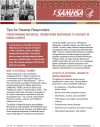Integrating traditional practices and social network visualization to prevent substance use: study protocol for a randomized controlled trial among urban Native American emerging adults
- PMID: 34565444
- PMCID: PMC8474938
- DOI: 10.1186/s13722-021-00265-3
Integrating traditional practices and social network visualization to prevent substance use: study protocol for a randomized controlled trial among urban Native American emerging adults
Abstract
Background: Nonmedical use of prescription opioids (defined as taking opioid medications for hedonic effects or in a manner other than prescribed) and the use of heroin have emerged in recent years as major public health concerns in the United States. Of particular concern is the prevalence of opioid use among emerging adults (ages 18-25), as this is a developmental period of heightened vulnerability and critical social, neurological, and psychological development. Data from 2015 show that American Indian/Alaska Native (AI/AN) people have the highest rates of diagnosis for opioid use disorders (OUDs). One recent study found that the overdose death rate among urban-dwelling AI/AN individuals was 1.4 times higher compared to those living in rural areas. To date, there are no evidence-based prevention programs addressing opioid use among urban AI/AN emerging adults that integrate culturally-appropriate strategies with evidence-based treatment. Traditions and Connections for Urban Native Americans (TACUNA) builds on our prior work with AI/AN communities across California to develop and evaluate culturally appropriate programming to address opioid, alcohol, and cannabis use among urban AI/AN emerging adults.
Methods/design: In a randomized controlled trial, 18-25 year old urban AI/AN emerging adults will receive either TACUNA (n = 185), which comprises three virtual workshops utilizing motivational interviewing, social network visualization, and integrating traditional practices and a wellness circle, or one virtual culturally sensitive opioid education workshop (n = 185). We will evaluate intervention effects on primary outcomes of frequency of opioid, alcohol, and cannabis use, as well as secondary outcomes of social network characteristics and cultural connectedness, over a 12-month period.
Discussion: This project has the potential to expand the range and effectiveness of opioid, alcohol, and cannabis services for urban AI/AN emerging adults by addressing the opioid epidemic and use of other substances at both the community and individual level. In addition, it provides important culturally grounded conceptual and practical information to advance the field of substance use interventions and enhance resiliency among this population.
Trial registration: ClinicalTrials.gov Identifier: NCT04617938. Registered October 26, 2020 https://clinicaltrials.gov/ct2/show/record/NCT04617938 .
Keywords: Alcohol and marijuana/cannabis use; Motivational interviewing; Native Americans; Opioid use; Social networks; Traditional practices.
© 2021. The Author(s).
Conflict of interest statement
The authors declare that they have no competing interests.
Figures











References
-
- Indian Health Service. HS implements groundbreaking new policy regarding opioid prescribing. Available at: https://www.ihs.gov/newsroom/ihs-blog/july2016/ihs-implements-groundbrea.... 2016.
-
- Center for Behavioral Health Statistics and Quality. National Survey on Drug Use and Health: Detailed Tables. Rockville, MD: Substance Abuse and Mental Health Services Administration; 2016.

